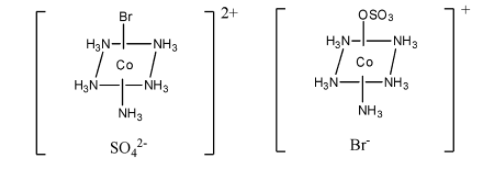
What is ionization isomerism? Give one example.
Answer
582k+ views
Hint: Isomerism is defined as the process where more than just one compound contains the same chemical formulas, but they have different chemical structures. There exists two types of isomerism namely structural isomerism and stereoisomerism.
Complete step-by-step solution:
Let us see the difference between structural and stereoisomers:
> The isomers in which the molecules having the same molecular formula are arranged with different bonding patterns and atomic orientation are called the structural isomerism. Structural isomerism is classified as chain isomers, positional isomers, functional isomers, metamerism, tautomerism and ring chain.
> The isomers in which the molecular bonds are placed in the same order and where the spatial arrangements differ are called the stereoisomers. Stereoisomers are classified as geometrical isomers and optical isomers.
> Ionisation isomerism is shown by such compounds in solution that give different ions although they possess the same chemical composition. Ionisation isomerism is seen to occur in a complex salt when its counter ion is a potential ligand and this counter ion can displace a ligand making it to behave or become a counter ion.
> One example of ionisation isomerism is $\left[ {{\rm{Co}}{{\left( {{\rm{N}}{{\rm{H}}_{\rm{3}}}} \right)}_{\rm{5}}}{\rm{S}}{{\rm{O}}_{\rm{4}}}} \right]{\rm{Br}}$ and $\left[ {{\rm{Co}}{{\left( {{\rm{N}}{{\rm{H}}_{\rm{3}}}} \right)}_{\rm{5}}}{\rm{Br}}} \right]{\rm{S}}{{\rm{O}}_{\rm{4}}}$.
> The structure of both the isomers $\left[ {{\rm{Co}}{{\left( {{\rm{N}}{{\rm{H}}_{\rm{3}}}} \right)}_{\rm{5}}}{\rm{S}}{{\rm{O}}_{\rm{4}}}} \right]{\rm{Br}}$ and $\left[ {{\rm{Co}}{{\left( {{\rm{N}}{{\rm{H}}_{\rm{3}}}} \right)}_{\rm{5}}}{\rm{Br}}} \right]{\rm{S}}{{\rm{O}}_{\rm{4}}}$are given below.

$\left[ {{\rm{Co}}{{\left( {{\rm{N}}{{\rm{H}}_{\rm{3}}}} \right)}_{\rm{5}}}{\rm{Br}}} \right]{\rm{S}}{{\rm{O}}_{\rm{4}}}$ $\,\,\,\,\,\,\,\,\,\,\,\,\,\,\,\,\,\,\,\,\,\,\,\,\,\,\,\,\,\,\,\,\,\,\,\,\,\,\,\,\,\,\,$ $\left[ {{\rm{Co}}{{\left( {{\rm{N}}{{\rm{H}}_{\rm{3}}}} \right)}_{\rm{5}}}{\rm{S}}{{\rm{O}}_{\rm{4}}}} \right]{\rm{Br}}$
We can prepare these ionisation isomers in the following way:
$\begin{array}{l}\left[ {{\rm{CoBr}}{{\left( {{\rm{N}}{{\rm{H}}_{\rm{3}}}} \right)}_{\rm{5}}}} \right]{\rm{S}}{{\rm{O}}_{\rm{4}}} \to {\left[ {{\rm{CoBr}}{{\left( {{\rm{N}}{{\rm{H}}_{\rm{3}}}} \right)}_{\rm{5}}}} \right]^{2 + }} + {\rm{SO}}_4^{2 - }\\{\rm{ Red - Violet}}\end{array}$
$\begin{array}{l}\left[ {{\rm{Co S}}{{\rm{O}}_{\rm{4}}}{{\left( {{\rm{N}}{{\rm{H}}_{\rm{3}}}} \right)}_{\rm{5}}}} \right]{\rm{Br}} \to {\left[ {{\rm{Co SO}}_4^{2 - }{{\left( {{\rm{N}}{{\rm{H}}_{\rm{3}}}} \right)}_{\rm{5}}}} \right]^ + } + {\rm{B}}{{\rm{r}}^ - }\\{\rm{ Red}}\end{array}$
Note: Students may get confused about how ionisation isomerism looks like. In ionisation isomerism, the compounds in solution give different ions although they possess the same chemical composition. The difference in ionisation isomerism is due to the difference in position of placing the atoms or groups in the coordination sphere.
Complete step-by-step solution:
Let us see the difference between structural and stereoisomers:
> The isomers in which the molecules having the same molecular formula are arranged with different bonding patterns and atomic orientation are called the structural isomerism. Structural isomerism is classified as chain isomers, positional isomers, functional isomers, metamerism, tautomerism and ring chain.
> The isomers in which the molecular bonds are placed in the same order and where the spatial arrangements differ are called the stereoisomers. Stereoisomers are classified as geometrical isomers and optical isomers.
> Ionisation isomerism is shown by such compounds in solution that give different ions although they possess the same chemical composition. Ionisation isomerism is seen to occur in a complex salt when its counter ion is a potential ligand and this counter ion can displace a ligand making it to behave or become a counter ion.
> One example of ionisation isomerism is $\left[ {{\rm{Co}}{{\left( {{\rm{N}}{{\rm{H}}_{\rm{3}}}} \right)}_{\rm{5}}}{\rm{S}}{{\rm{O}}_{\rm{4}}}} \right]{\rm{Br}}$ and $\left[ {{\rm{Co}}{{\left( {{\rm{N}}{{\rm{H}}_{\rm{3}}}} \right)}_{\rm{5}}}{\rm{Br}}} \right]{\rm{S}}{{\rm{O}}_{\rm{4}}}$.
> The structure of both the isomers $\left[ {{\rm{Co}}{{\left( {{\rm{N}}{{\rm{H}}_{\rm{3}}}} \right)}_{\rm{5}}}{\rm{S}}{{\rm{O}}_{\rm{4}}}} \right]{\rm{Br}}$ and $\left[ {{\rm{Co}}{{\left( {{\rm{N}}{{\rm{H}}_{\rm{3}}}} \right)}_{\rm{5}}}{\rm{Br}}} \right]{\rm{S}}{{\rm{O}}_{\rm{4}}}$are given below.

$\left[ {{\rm{Co}}{{\left( {{\rm{N}}{{\rm{H}}_{\rm{3}}}} \right)}_{\rm{5}}}{\rm{Br}}} \right]{\rm{S}}{{\rm{O}}_{\rm{4}}}$ $\,\,\,\,\,\,\,\,\,\,\,\,\,\,\,\,\,\,\,\,\,\,\,\,\,\,\,\,\,\,\,\,\,\,\,\,\,\,\,\,\,\,\,$ $\left[ {{\rm{Co}}{{\left( {{\rm{N}}{{\rm{H}}_{\rm{3}}}} \right)}_{\rm{5}}}{\rm{S}}{{\rm{O}}_{\rm{4}}}} \right]{\rm{Br}}$
We can prepare these ionisation isomers in the following way:
$\begin{array}{l}\left[ {{\rm{CoBr}}{{\left( {{\rm{N}}{{\rm{H}}_{\rm{3}}}} \right)}_{\rm{5}}}} \right]{\rm{S}}{{\rm{O}}_{\rm{4}}} \to {\left[ {{\rm{CoBr}}{{\left( {{\rm{N}}{{\rm{H}}_{\rm{3}}}} \right)}_{\rm{5}}}} \right]^{2 + }} + {\rm{SO}}_4^{2 - }\\{\rm{ Red - Violet}}\end{array}$
$\begin{array}{l}\left[ {{\rm{Co S}}{{\rm{O}}_{\rm{4}}}{{\left( {{\rm{N}}{{\rm{H}}_{\rm{3}}}} \right)}_{\rm{5}}}} \right]{\rm{Br}} \to {\left[ {{\rm{Co SO}}_4^{2 - }{{\left( {{\rm{N}}{{\rm{H}}_{\rm{3}}}} \right)}_{\rm{5}}}} \right]^ + } + {\rm{B}}{{\rm{r}}^ - }\\{\rm{ Red}}\end{array}$
Note: Students may get confused about how ionisation isomerism looks like. In ionisation isomerism, the compounds in solution give different ions although they possess the same chemical composition. The difference in ionisation isomerism is due to the difference in position of placing the atoms or groups in the coordination sphere.
Recently Updated Pages
A man running at a speed 5 ms is viewed in the side class 12 physics CBSE

State and explain Hardy Weinbergs Principle class 12 biology CBSE

Which of the following statements is wrong a Amnion class 12 biology CBSE

Two Planoconcave lenses 1 and 2 of glass of refractive class 12 physics CBSE

The compound 2 methyl 2 butene on reaction with NaIO4 class 12 chemistry CBSE

Bacterial cell wall is made up of A Cellulose B Hemicellulose class 12 biology CBSE

Trending doubts
What are the major means of transport Explain each class 12 social science CBSE

Which are the Top 10 Largest Countries of the World?

Draw a labelled sketch of the human eye class 12 physics CBSE

Explain sex determination in humans with line diag class 12 biology CBSE

Give 10 examples of unisexual and bisexual flowers

State the principle of an ac generator and explain class 12 physics CBSE




